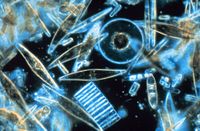
Photo from wikipedia
Abstract The isolated diatom Nitzschia punctata was subjected to different trophic modes - autotrophy, heterotrophy, and mixotrophy and evaluated variations in growth rate, morphology, biochemical composition, and fatty acid profiles… Click to show full abstract
Abstract The isolated diatom Nitzschia punctata was subjected to different trophic modes - autotrophy, heterotrophy, and mixotrophy and evaluated variations in growth rate, morphology, biochemical composition, and fatty acid profiles of diatoms in response to different nutritional modes. Glucose was used as a nutrient source in hetero and mixotrophic cultivation. Significant morphological variations in mucilage (jelly) stalks were found in hetero- and mixotrophically grown diatoms. The biomass yield was highest in mixotrophic diatoms (139.16 ± 3 mg/L), followed by autotrophic (127.04 ± 4 mg/L) and heterotrophically grown diatoms (95.22 ± 3 mg/L). Confocal microscopy studies using Nile red revealed significant bright yellow-gold fluorescence dispersed intermittently along with the mucilage stalks of mixotrophic and heterotrophic diatom cultures. Fourier transform infra-red (FTIR) spectroscopic studies showed a sharp absorption peak in hetero- and mixotrophic cultures at 1741 cm-1, indicating the presence of esters of fatty acids (R-C(O)-O-R). Elemental composition analysis using scanning electron microscopy revealed higher C (~48%) in mixotrophic cultivation. Fatty acid methyl esters (FAME) assessment through Gas chromatography and mass spectroscopy (GC–MS) showed higher proportions of palmitoleic acid (C16:1; ~18 – 29%) and oleic acid (C18:1; ~26 – 35%) with saturates and monounsaturates of C16 – C18 up to 90%, confirming of superior biodiesel quality property, which is desirable. The presence of Eicosapentaenoic acid (EPA) in hetero- and mixotrophic cultivation proves the scope for its potential utilisation as a source of bioactive compounds for industrial application.
Journal Title: Fuel
Year Published: 2021
Link to full text (if available)
Share on Social Media: Sign Up to like & get
recommendations!